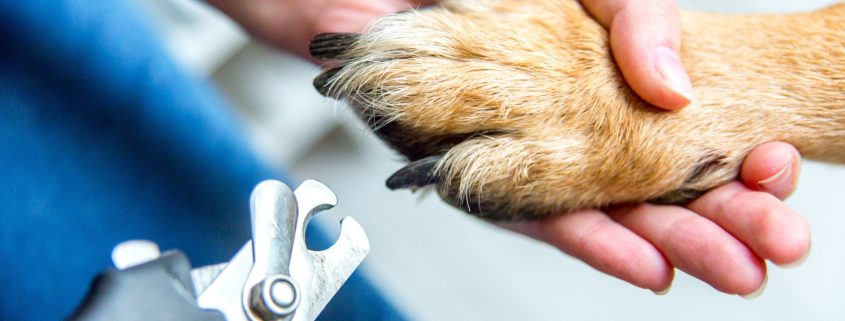There is nothing more intimidating than clipping your dog’s nails. When you go to grooming salons, it may look like a piece of cake, but the reality is that trimming your dog’s nails is a tricky thing to do. If your pooch doesn’t want to have their nails clipped, chances are, they will be moving and wiggling around, making your job even harder. Having the right tools at your disposal is one piece of the puzzle that will make this process go a bit smoother.
Below we cover nail length, as well as the pros and cons of dremels vs. clippers. From there, you can choose what is best for you and your dog!
How Long Should Your Dog’s Nails Be?
Ideally, your dog’s nails shouldn’t touch the ground when they’re standing square on a level surface. If their nails do touch the ground, it’s okay! In time, a regular nail-trimming routine can get your dog’s nails to the appropriate length. In fact, it’s recommended that you don’t try to go very short if it’s the first time you’ve trimmed your pup’s nails.
Instead, you’ll want to start out slow and trim off small amounts, being careful of the vein in your dog’s nails – called the quick – which can elongate without regular nail trimmings. To get your dog’s nails trimmed to a healthy length, you’ll need to be patient and consistent in your trimming routine, and it may take several sessions the first few times.
Which Tool Should You Use?
To help you tackle th job of nail trimming, there are a handful of options for getting the job done. Clippers are the most common tools used to trim a dog’s nails, and they come in two forms: guillotine style and scissor style. Another handy tool is the nail dremel, which files the nail away instead of cutting.
Ultimately, the answer comes down to your personal preference and how confident and safe you feel using these tools. It also depends on your dog. If clippers nicked one of their quicks once, they might refuse to let them anywhere near their paws. But if your dog won’t tolerate loud noises, they might run at the sound of the dremel. Both of these things can be overcome with training—to a degree—but could influence your choice.
Below is a list of pros and cons of each tool for you to explore before making the decision of which to use.
DREMEL
- PRO: Safer and provides more control.
- PRO: Comes with replacement sanding bands.
- PRO: Works well on thick nails and dark colored nails.
- PRO: Wears down sharp edges.
- CON: Requires a battery and charger.
- CON: Can be on the more expensive side.
- CON: Can get hot and overheat with prolonged use.
CLIPPERS
- PRO: Easily portable.
- PRO: More affordable.
- PRO: Will not overheat.
- CON: Offers less control, which could lead to cutting the quick.
- CON: Requires replacement or sharpening when they get dull.
- CON: Requires greater pressure to cut thick nails, which can cause discomfort.
- CON: Leaves sharp edges that require filing.
Styptic Powder to the Rescue!
No matter which tool you choose, it’s a good idea to have styptic powder at the ready when you cut your dog’s nails in case you do cut the quick and your dog bleeds. This inexpensive powder contains benzocaine to relieve pain and ferric subsulfate to stop bleeding. Simply dip the injured nail directly into the powder or apply to the nail with a Q-tip and hold for a few minutes until the bleeding stops.
For more information on nail trimming as well as additional grooming tips and tricks, check out our previous blog “Grooming Tips for Dogs”.
Your Pets are our Priority!
At the National Animal Supplement Council (NASC), our number one priority is to promote the health and wellbeing of your pets. That is why we created the NASC Audit Program and the Quality Seal, which helps you identify animal health and nutritional supplements that come from responsible suppliers committed to producing the highest quality, most consistent products available. Visit our website to learn more and to see a list of NASC members that have earned the Quality Seal.


